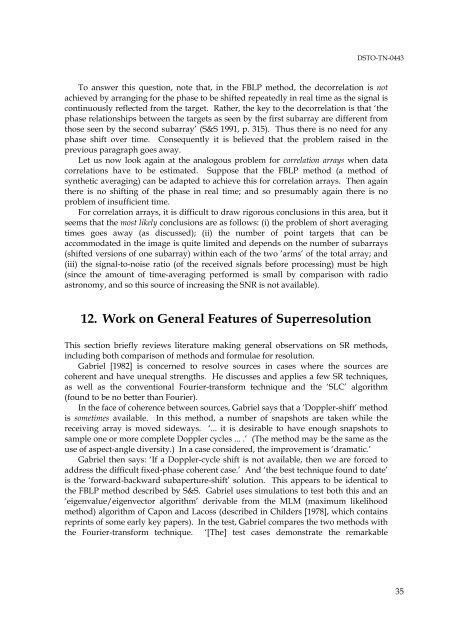Suitability of Correlation Arrays and Superresolution for Minehunting ...
Suitability of Correlation Arrays and Superresolution for Minehunting ...
Suitability of Correlation Arrays and Superresolution for Minehunting ...
Create successful ePaper yourself
Turn your PDF publications into a flip-book with our unique Google optimized e-Paper software.
DSTO-TN-0443<br />
To answer this question, note that, in the FBLP method, the decorrelation is not<br />
achieved by arranging <strong>for</strong> the phase to be shifted repeatedly in real time as the signal is<br />
continuously reflected from the target. Rather, the key to the decorrelation is that ‘the<br />
phase relationships between the targets as seen by the first subarray are different from<br />
those seen by the second subarray’ (S&S 1991, p. 315). Thus there is no need <strong>for</strong> any<br />
phase shift over time. Consequently it is believed that the problem raised in the<br />
previous paragraph goes away.<br />
Let us now look again at the analogous problem <strong>for</strong> correlation arrays when data<br />
correlations have to be estimated. Suppose that the FBLP method (a method <strong>of</strong><br />
synthetic averaging) can be adapted to achieve this <strong>for</strong> correlation arrays. Then again<br />
there is no shifting <strong>of</strong> the phase in real time; <strong>and</strong> so presumably again there is no<br />
problem <strong>of</strong> insufficient time.<br />
For correlation arrays, it is difficult to draw rigorous conclusions in this area, but it<br />
seems that the most likely conclusions are as follows: (i) the problem <strong>of</strong> short averaging<br />
times goes away (as discussed); (ii) the number <strong>of</strong> point targets that can be<br />
accommodated in the image is quite limited <strong>and</strong> depends on the number <strong>of</strong> subarrays<br />
(shifted versions <strong>of</strong> one subarray) within each <strong>of</strong> the two ‘arms’ <strong>of</strong> the total array; <strong>and</strong><br />
(iii) the signal-to-noise ratio (<strong>of</strong> the received signals be<strong>for</strong>e processing) must be high<br />
(since the amount <strong>of</strong> time-averaging per<strong>for</strong>med is small by comparison with radio<br />
astronomy, <strong>and</strong> so this source <strong>of</strong> increasing the SNR is not available).<br />
12. Work on General Features <strong>of</strong> <strong>Superresolution</strong><br />
This section briefly reviews literature making general observations on SR methods,<br />
including both comparison <strong>of</strong> methods <strong>and</strong> <strong>for</strong>mulae <strong>for</strong> resolution.<br />
Gabriel [1982] is concerned to resolve sources in cases where the sources are<br />
coherent <strong>and</strong> have unequal strengths. He discusses <strong>and</strong> applies a few SR techniques,<br />
as well as the conventional Fourier-trans<strong>for</strong>m technique <strong>and</strong> the ‘SLC’ algorithm<br />
(found to be no better than Fourier).<br />
In the face <strong>of</strong> coherence between sources, Gabriel says that a ‘Doppler-shift’ method<br />
is sometimes available. In this method, a number <strong>of</strong> snapshots are taken while the<br />
receiving array is moved sideways. ‘... it is desirable to have enough snapshots to<br />
sample one or more complete Doppler cycles ... .’ (The method may be the same as the<br />
use <strong>of</strong> aspect-angle diversity.) In a case considered, the improvement is ‘dramatic.’<br />
Gabriel then says: ‘If a Doppler-cycle shift is not available, then we are <strong>for</strong>ced to<br />
address the difficult fixed-phase coherent case.’ And ‘the best technique found to date’<br />
is the ‘<strong>for</strong>ward-backward subaperture-shift’ solution. This appears to be identical to<br />
the FBLP method described by S&S. Gabriel uses simulations to test both this <strong>and</strong> an<br />
‘eigenvalue/eigenvector algorithm’ derivable from the MLM (maximum likelihood<br />
method) algorithm <strong>of</strong> Capon <strong>and</strong> Lacoss (described in Childers [1978], which contains<br />
reprints <strong>of</strong> some early key papers). In the test, Gabriel compares the two methods with<br />
the Fourier-trans<strong>for</strong>m technique. ‘[The] test cases demonstrate the remarkable<br />
35

















